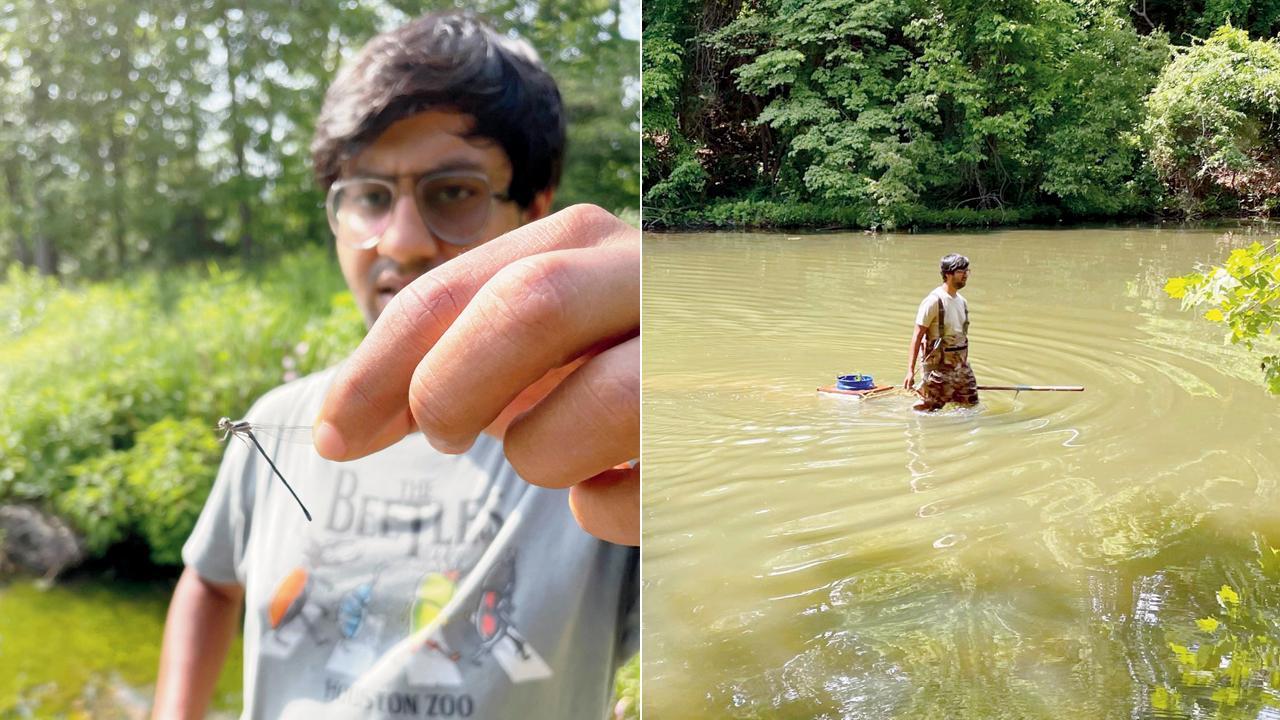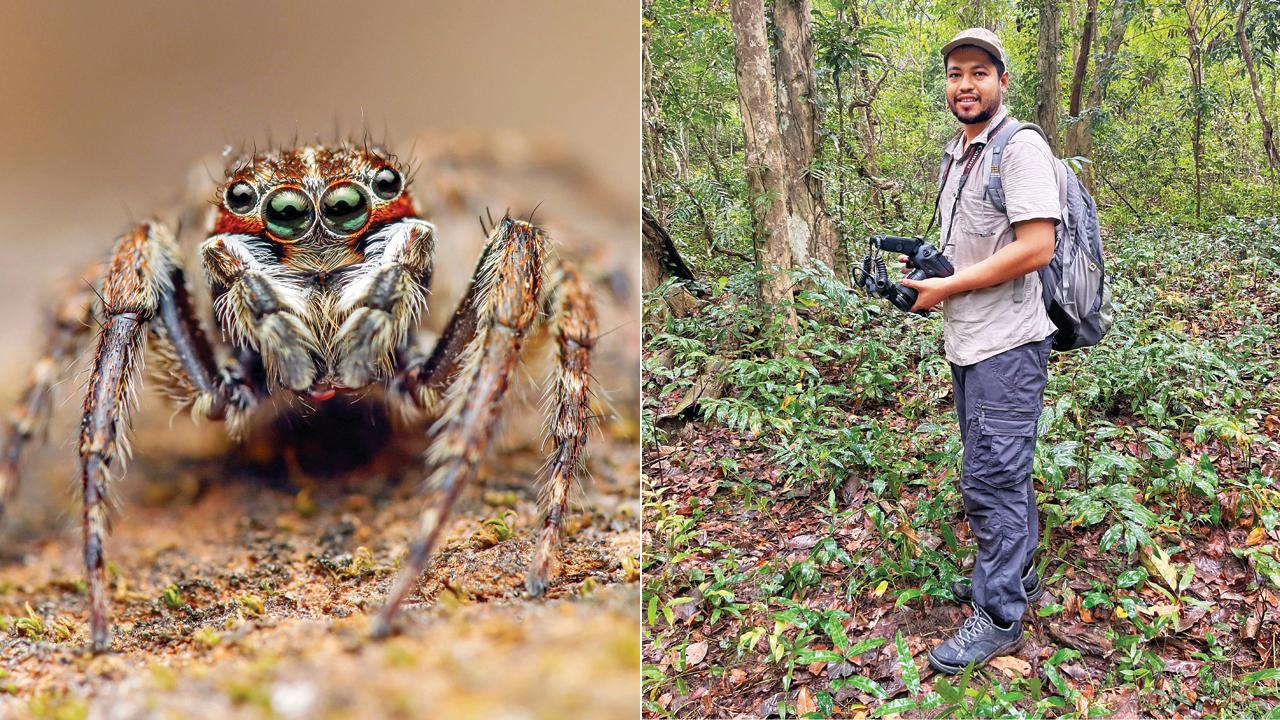In 2022 alone, 664 new animal species were discovered in India. Wildlife researchers take us behind the scenes, revealing the rigour and patience that makes such discoveries possible

For over a decade, Shantanu Joshi has worked on the diversity and ecology of Indian Odonata, finding new species in the northeast and Western Ghats
People's perception of spiders may change if they had the chance to understand them and their behaviour better. If you look at them closely—in macro photographs—it is their beauty that comes across,” says arachnologist Rishikesh Tripathi. The 29-year-old is pursuing his PhD on eight-legged creatures found in the Thar desert and speaks of them in a way that can only be described as mesmerised. He patiently explains why their physical attributes vary based on their habitat. “Those found in the desert, for example, have long legs so they can avoid the heat. Their lack of colour stems from the need to camouflage themselves.”
When Mumbai-based Tripathi learnt that India has 2,000 identified species of spiders, he found himself fascinated and challenged to photograph as many as he could. His collection of 600 documented species is a testament to how seriously he took the project. “Every time I come across a species for the first time, I feel the same joy that a birder may experience during their debut sighting of a bird,” he says to mid-day. But perhaps the real feather in the arachnologist’s cap is that he has “described” 12 Indian species that were previously unidentified or unknown, from the Western Ghats, Himalayas to the Thar Desert.
 Pic/Pranav Joshi; (right) Rishikesh Tripathi has described 12 species of spiders in India, from the Himalaya, Thar Desert and Western Ghats
Pic/Pranav Joshi; (right) Rishikesh Tripathi has described 12 species of spiders in India, from the Himalaya, Thar Desert and Western Ghats
Across India, scientists and wildlife researchers like Tripathi are discovering new species of flora and fauna, enriching our knowledge about the country’s biodiversity and ecosystems. In 2022 alone, 664 animal species were added to our faunal database, as declared by the Zoological Survey of India. Names like the sela macaque and yellow-rumped flycatcher made headlines, but they are only a handful from among hundreds who were
meticulously documented.
What does it actually take to discover a new species? Do scientists actively chase leads, explore remote geographies or come across these finds by chance? Three individuals working across taxonomy, odonatology (the study of dragonflies and damselflies) and arachnology tell us stories from their fieldwork and desks—of trial and error, intrigue and hard work.
 Over the course of his 34-year career, Rajan has described over a hundred species. Pics/Sahana Shree
Over the course of his 34-year career, Rajan has described over a hundred species. Pics/Sahana Shree
For the intrepid researcher, “describing” a new species is essential to its acknowledgment at a discipline level. Description is the arduous process of collecting male and female specimens, photographing them, comparing them to other species in the same genus, identifying them as taxonomically distinct, and finally, publishing an academic paper in a peer-reviewed journal.
This writer expected to find stories of disappointment and heartbreak over months-long projects that did not make the cut. But what emerged was a commitment to rigour and scientific objectivity. “I like to be as cautious as possible and take my time with this kind of work,” says Shantanu Joshi, who is pursuing a PhD in Biological Sciences from the University of Arkansas.
Joshi, 28, recalls childhood memories of bringing fish from his grandmother’s village in rural Raigad to his home, and trawling the Internet to identify them. Like many in wildlife, his own entrypoint into the subject was bird watching; later, he took an interest in insects. “In particular, I found dragonflies striking. I also realised that there was very little information about them—not enough to even identify the species I was seeing,” he says. Joshi chose odonatology as his discipline to help fix this information gap.
A crucial (and fun) aspect of discovery and description is the naming of the new species. Some names draw from the animal’s own characteristics. Closer home, Tripathi and his peers named the Hasarius mumbai ‘jumping spider’ after the city because it has made the streams of the Bombay Natural History Society’s conservation education centre its home. And some names are truly special: In 2020, when Joshi and herpetologist Anuja Mital discovered a new species of dragonfly in Assam’s Tezpur, the duo named it after two trailblazing female conservationists in the north east. ‘Platygomphus benritarum’ honours Monisha Behal and Rita Banerji, founders of the North East Network founder and Green Hub respectively.
Priyadarsanan Dharma Rajan, 59, has an easy laugh. He can also recall in crystal clear detail his first discovery—a new species of fig wasp pollinating Ficus beddomei, an endemic fig tree of the Western Ghats. Recently, Rajan and his team retraced the route of a British-era colonial expedition to the Siang Valley, which shed light on the largely unknown insect diversity in the region. A Senior Fellow at the Ashoka Trust for Research in Ecology and the Environment (ATREE), one of Rajan’s finds from the expedition included a velvet worm [Typhloperipatus williamsoni] which was thought to be lost to time. The entomologist and his team ably collected the worm in a glass jar, enabling the rediscovery of this ‘living fossil’ after a century.
Reflecting on his 34-year career and the 100+ discoveries to his name, Rajan eloquently reminds us that the spirit of science should never be forgotten. “The discovery of a new species is certainly exciting, but it should also excite us when another scientist or academic critically engages with our findings! This is essential to the basic philosophy of science—it’s what makes it more revolutionary than even political revolutions.”
One may think that the ability to spot new species in an era where endangerment of fauna and habitat loss have become frightening realities can be a source of optimism—and a humbling reminder of how little we know of the Earth’s rich ecosystems. After all, only one-fourth of the estimated 8.7 million species of plants and animals have been described, scientists say.
Yet, in keeping their ears to the ground, wildlife researchers are witness firsthand to the radical and swift destruction of habitats at the hands of humans. Indeed, species discovery can sometimes shine the spotlight on animals who are already endangered or extinct, like East Africa’s stingless bees. Tripathi describes returning to some locations as being a harsh experience. “These spaces unexpectedly transform into apartment buildings or land used for agriculture. When we first visited the location in Kerala where I found a new species of spider, we could only collect the male specimen. I decided to wait a season to collect the female, but the next year, the habitat looked nothing like it did in the past,” the arachnologist rues.
“It is both hopeful and intriguing to know that there is something new, something more even in a particular patch of forest,” Joshi says, adding sombrely, “But it is tough not to be worried by changes like the one I saw in a project about how habitats affect dragonfly communities. In Karnataka, ten feet away from where I found a new species of damselfly [Protosticta myristicaensis], their habitat was being converted into areca
nut plantations.”
And then there are systemic challenges, from the state of documentation and inventorying in India, to the lack of funding for individuals as well as opportunities at institutions like natural history museums. Consider all those species documented by British surveyors, whose records and collections are no longer found in India, compelling Indian researchers to wait for long periods before they can obtain data or photographs necessary for their academic work. Additionally, for many, species discovery is a secondary project separate from their day jobs—pursuits driven by passion and curiosity, sometimes in collaboration with organisations like the Zoological Survey of India.
A contrast to this grim reality is the exuberance of citizen science platforms and communities on social media, populated by enthusiasts, wildlife photographers and experts across disciplines. “Thanks to contributors’ finds and photographs, we’re able to visit locations and expand what we know about spiders. This has made species discovery an easier process today than it was in yesteryears,” says Tripathi.
These citizen forums were foundational to Joshi’s career, who quickly transformed from novice to researcher over the course of his Master’s degree and now his PhD. It was the Veino family of Nagaland’s Dimapur who pointed him in the direction of rare dragonflies in the state. Initially, they posted only about butterflies, later taking an interest in dragonflies. They find a mention in the acknowledgments of a paper on new species, and are co-authors of another paper on new additions and records. “Watching the family’s seven-year-old and 12-year-old children know and identify all the dragonflies found around their home and at a nearby stream was very cool. Some of these species were incredibly rare—the sort that hadn’t been seen for decades,” Joshi says, in awe.
664
No. of new animal species discovered in India in 2022
 Subscribe today by clicking the link and stay updated with the latest news!" Click here!
Subscribe today by clicking the link and stay updated with the latest news!" Click here!










